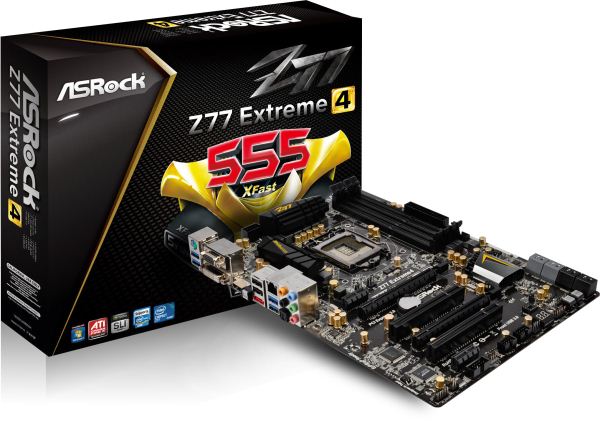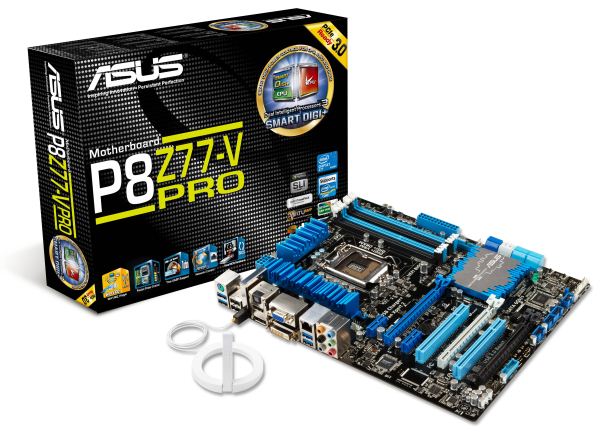Intel Z77 Motherboard Review with Ivy Bridge - ASRock, ASUS, Gigabyte, and MSI
by Ian Cutress on May 7, 2012 7:40 PM EST- Posted in
- Motherboards
- MSI
- Gigabyte
- ASRock
- Asus
- Ivy Bridge
- Z77
Conclusion – ASRock Z77 Extreme4
I had high expectations of the ASRock product due to what we have seen in previous chipsets. Over time, they have developed this knack of offering a good performance product at a great price, and a large amount of free kit in the box to sweeten the deal.
The Z77 Extreme4 is the lower end enthusiast board coming out from ASRock at release (compared to a total 20 models listed on their website). Therefore, when it comes in at $135, we should like this price. In the box is not substantial, with just a pair of SATA cables and an SLI finger, but we are treated to the ASRock BIOS and Software package. The big addition on the package is the Internet Flash software, allowing users to update their BIOS to the latest without needing to download it in an Operating System.
Performance wise, ASRock seem to be lacking the enhanced Turbo option utilized by other motherboard manufacturers by default, so we may see it in future BIOS builds. The XFast LAN software also shows superior performance in incompressible transfers or real-world transfers compared to standard USB throughput.
By making this board a little bit smaller than ATX, this board is cheaper than the rest and I really like the styling. As long as you remember to adjust the default CPU fan speed, this inexpensive board would be a good choice for an Ivy Bridge build.
Conclusion – ASUS P8Z77-V Pro
Whenever a reviewer deals with a variety of products at different price points, thoughts go through the mind of a reviewer about where that additional money has gone. If you look at an ASUS board, the usual culprits pop up - vastly improved fan controls, superior BIOS and software, digital power delivery, and a general feel that the board is solidly built. ASUS has gone another step further with their Z77 range, and on the Pro this means an Intel NIC as standard, onboard WiFi, USB Flashback, all four Ivy Bridge video outputs available, USB 3.0 Boost, Q-LED for POST diagnosis, and even a Thunderbolt header which connects to a future ASUS Thuderbolt add-in card (sold separately).
Performance on the P8Z77-V Pro is bolstered by the MultiCore Enhancement BIOS setting, which invokes maximum turbo mode for any core loading by default giving multi-threaded results an advantageous score. I feel this sort of setting will quickly become the standard, as motherboard manufacturers try to provide the best bang for buck on their products.
Despite the mishap regarding my CPU cooler (which is of an old design), there is not much I can complain about on the P8Z77-V Pro. It overclocked a set of G.Skill DDR3-2666 memory to DDR3-2950 with a little increase in voltage without issue, and it overclocked the CPU rather vigorously to give 4774 MHz, even if it was a little toasty under load.
At $225/$235, the motherboard spectrum for Ivy Bridge will separate the very cheap and the very functional. For a long-term build, the ASUS P8Z77-V Pro is a solid choice, and even has ASUS Premium Service warranty if you are in North America.
Update: I have just been informed that the Pro will soon drop in MSRP to $209. This makes it even more affordable.












117 Comments
View All Comments
faizoff - Monday, May 7, 2012 - link
Are Q connectors proprietary of ASUS? I seem to find those only their motherboards. Love them to death.Great review. I enjoy these tremendously. Almost makes me go out and upgrade my i5 2500k.
Impulses - Monday, May 7, 2012 - link
My MSI P67A-GD55 has the same thing, unfortunately the connector block is too tall and bumps into my second 6950 so I couldn't use it.eBob - Tuesday, May 8, 2012 - link
I, too, am a fan of the Q Connector mostly for the front panel connections (power, reset, HDD light). The USB and audio connectors seem to be pretty well standardized at this point, rendering those Q Connectors redundant IMO. This would seem to be a very simple and inexpensive feature for a mobo manufacturer to have (at least for the front panel connector).bji - Monday, May 7, 2012 - link
Thank you for including this important benchmark. I hope that every motherboard review going forward will include this.The ASRock has the best time but 8 seconds is still too long. I wonder why BIOS developers can't get their act together and initialize hardware in parallel. That would surely speed POST times up tremendously.
adrianlegg - Monday, May 7, 2012 - link
I've been struggling about that issue myself. I mean - it probably was in times of BIOS, but now, with all fancy UEFI is it really that hard? (considering more resources spent on bios/uefi in mobo)Altough I'm not big fan of 200$+ motherboards, I would seriously consider buying one if it POST in 2s.
Even though there are probably POST requirements such as cpu cant be tested before ram or opposite it would be awesome to have really low boot times.
Sad when even having SSD cant give You instant full boot (not hibernations/sleeps).
It's one of those small features that are soo awesome (like reset/power buttons, and perhaps, in future : complete per component (ram/disk/SB/NB/coolers) power usage).
Nevertheless 8seconds is damn nice.
EnzoFX - Monday, May 7, 2012 - link
Does anyone know how enabling AHCI in the UEFI affect post time these days? I'd like to remove the other 7-10 seconds this adds to it.pixelstuff - Monday, May 7, 2012 - link
How do those Chromebooks shave time off of the POST? Seems like similar techniques could be implemented unless there is a good reason not to.rahvin - Tuesday, May 8, 2012 - link
Chromebooks use OpenBIOS IIRC. OpenBIOS is Linux Kernel based and boots very fast because it initializes things quicker and it's custom built to the hardware on the board. Personally I wish all the Boards would start using it and toss these BIOS down the hole of history.DanNeely - Tuesday, May 8, 2012 - link
They've got a very stripped down set of hardware to initialize. The more stuff you have on board, the longer it takes. EFI was supposed to fix this by allowing multi-threaded boot (BIOS was strictly a single threaded design); but either firmware makers aren't generally taking advantage of it yet, or dependencies in the startup process are limiting the gains.Jase89 - Sunday, May 19, 2013 - link
Don't forget the graphics card (if using discrete) will need to support UEFI (GOP) Booting too!